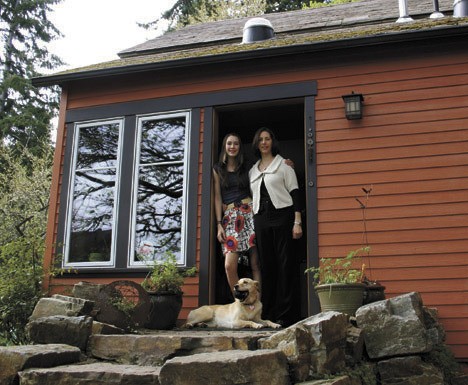Emily Burns fell in love, quite by accident, in 2002 — with a charming two-story farmhouse on Vashon Highway. “I never intended to live on Vashon Island,” said Burns, an asset management strategic advisor with the Seattle Transportation Department. “But when I drove up the driveway and saw the house, my heart started beating really fast.”
When Burns signed the purchase-and-sale agreement, infatuation turned serious, and she made a commitment to bring her drafty, un-insulated, baseboard heated, century-old farmhouse into the 21st century.
For months, Burns scoured the Internet for information about alternative insulation, prowled salvage stores for recycled materials, researched Puget Sound Energy’s rebate programs and invested plenty of her own sweat equity. Burns’ 107-year-old farmhouse is now energy-efficient. But it took a lot of hard work to get there.
“In the beginning, it was cold,” said Burns. “You had to stand right next to the heater to stay warm.” So the first item on her renovation agenda was storm windows to cut down on drafts.
Next up: Replacing her electric baseboard heating system. She installed 1920s-era cast-iron radiators with a natural gas boiler. After the last big snow storm in 2008, Burns added a Danish RAIS wood-burning stove designed to be carbon-dioxide neutral. “It is all enclosed,” explained Burns. “It’s a stand-alone unit with high efficiency.”
Then came the insulation, and that’s when the work got interesting. Burns faced several challenges.
She wanted to insulate her front parlor without tearing down its lath and plaster walls. She was determined to find alternatives to standard fiberglass insulation, because its airborne particulates set off her allergies. And to keep costs down, she needed an insulation she could install herself.
Burns went online and hit the trifecta. “Tiger Foam,” said Burns. “It’s a slow-release, closed-cell product with a vapor barrier, so it fills the area completely. There’s no off-gas when it dries so it’s non-allergenic.”
Best of all, she added, the Tiger Foam was DIY. “I drilled small holes at four feet, took two canisters, and sprayed foam in the holes. It was fun.”
Insulating the kitchen was a bit more complex. Unlike the parlor, the kitchen needed drywall. The solution this time? Blue jeans. Collected from manufacturers’ discards, denim remnants or off-cuts can be spun into a fluffy — and healthier — alternative to fiberglass. Once the Tiger Foam dried, Burns covered it with the blue jean batting before setting the drywall. Like the Tiger Foam, Burns found the denim insulation easy to work with.
The final insulating touch came in January, when Burns used yet another new product called Eco Batts to seal up her basement. Only this time she hired some Island contractors to do the work. The contractors tipped her off to Puget Sound Energy’s insulation rebate program. As a PSE customer, Burns was eligible for up to $400 in deductions off the bid of an authorized PSE contractor. Now, with the anticipated savings, she plans to attack the attic next.
Burns is still calculating the cost savings from all her upgrades. “But comfort-wise, the difference is huge,” she said. “During moderate months, we don’t even turn on the radiators. The house retains the heat. Drafts from the floors, windows, and doors are all gone. Now it is warm, and we love living here.”
She also feels she’s made a significant contribution to the environment — as she now owns a house that will likely stand the test of time for decades to come.
“The bones of this house are so strong,” she said. “We really wanted to give this place new life — and make it last another 100 years.”
WisEnergy, a project of Sustainable Vashon, is working to reduce Vashon’s energy consumption. The group’s goal: to reduce the Island’s energy consumption by 12 percent by 2012. The group has established a small house at the Village Green that is being retrofitted with energy-saving products and serves as a demonstration site. The group also has an active Web site, with information about what you can do in your own home to reduce energy, stay warm and save money. Visit it at www.wiseneryvashon.com.



